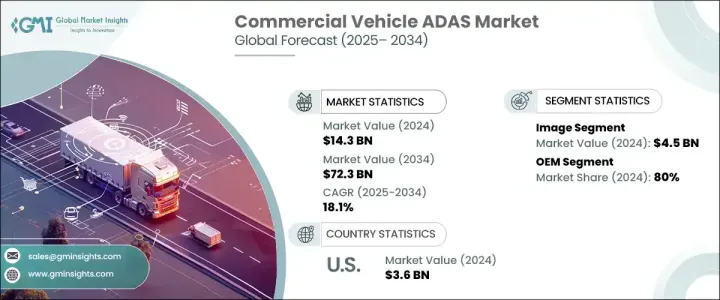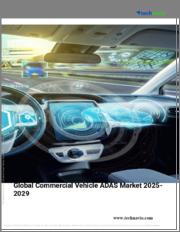
|
시장보고서
상품코드
1708153
세계의 상용차 ADAS 시장 기회, 성장 촉진요인, 산업 동향 분석 및 예측(2025-2034년)Commercial Vehicle ADAS Market Opportunity, Growth Drivers, Industry Trend Analysis, and Forecast 2025 - 2034 |
||||||
세계 상용차 ADAS 시장은 2024년 143억 달러 규모로 평가되어쏘, 2025년부터 2034년까지 연평균 18.1% 성장할 것으로 예측됩니다.
세계적으로 안전 규제가 강화되고 상용차 사업자들이 첨단운전자보조시스템(ADAS)를 도입하면서 시장이 크게 성장하고 있습니다. 교통 안전, 사고 예방, 규제 준수에 대한 관심이 높아지면서 북미, 유럽, 아시아 일부 지역에서 ADAS 솔루션에 대한 수요가 급증하고 있습니다. 각국 정부는 운전자의 피로, 주의 산만, 차선 유지 등을 모니터링하는 통합 시스템을 의무화하는 엄격한 정책을 시행하고 있으며, 이는 ADAS의 채택을 더욱 가속화하고 있습니다. 이러한 기술은 특히 장거리 트럭 운송 및 도시 상업용 운송에서 인적 오류로 인한 사고를 줄이는 데 필수적임이 입증되고 있습니다. 또한, AI 기반 ADAS 기능의 통합은 안전과 업무 효율성을 향상시켜 최신 상용차에 필수적인 요소로 자리 잡고 있습니다.

시장은 레이더, LiDAR, 초음파, 이미지 및 기타 센서를 포함한 센서 유형에 따라 분류됩니다. 이 중 이미지 센서 분야가 30%의 점유율을 차지하며 2024년 45억 달러를 창출할 것으로 예측됩니다. 이미지 센서는 차선 이탈 경고, 교통 표지판 인식, 충돌 감지 등 시각 기반 ADAS 기능에서 중요한 역할을 합니다. 이러한 센서는 실시간 비디오 캡처 및 처리를 통해 작동하며, 상업용 운전자가 복잡한 교통 상황을 안전하게 탐색할 수 있도록 지원합니다. 자동화 및 머신러닝 기능이 발전함에 따라 상용차 ADAS의 고해상도 이미지 센서에 대한 의존도가 높아져 차량의 반응성과 사고 예방이 향상되고 있습니다.
| 시장 범위 | |
|---|---|
| 시작 연도 | 2024년 |
| 예측 연도 | 2025-2034년 |
| 시작 금액 | 143억 달러 |
| 예상 금액 | 723억 달러 |
| CAGR | 18.1% |
상용차 ADAS 시장은 판매 채널에 따라 OEM(주문자상표부착생산)과 애프터마켓 솔루션으로 구분되며, 2024년에는 OEM 부문이 80% 시장 점유율을 차지했습니다. OEM은 ADAS 기술을 차량 제조 시 차량에 직접 통합하고 필수 안전 기능을 표준 또는 옵션으로 제공합니다. 차량 소유주들이 신뢰성, 효율성, 규제 준수에 대한 우선순위를 부여함에 따라 공장 출고 시 안전 시스템에 대한 선호도가 높아짐에 따라 OEM의 우위가 커지고 있습니다. 이러한 내장형 통합은 상용차에 최첨단 ADAS 기술을 장착할 수 있는 원활하고 효율적인 접근 방식을 제공합니다.
북미는 35%의 점유율로 상용차 ADAS 시장을 주도하고 있으며, 미국에서만 2024년 시장 규모는 36억 달러에 달했습니다. 미국에는 장거리 트럭, 배송 밴, 대중교통 차량을 포함한 방대한 상용차 차량이 있어 ADAS 솔루션에 대한 높은 수요를 창출하는 데 일조하고 있습니다. 안전성 향상, 운전 효율성 향상, 연료 소비 감소는 미국 내 ADAS 기술 채택을 촉진하는 주요 요인입니다. 차량 사업자들은 교통 안전 강화, 보험 비용 절감, 운전자들의 전반적인 성능 향상을 위해 이러한 시스템에 많은 투자를 하고 있습니다. 기술이 계속 발전함에 따라 상용차 ADAS 시장은 규제 지원, 기술 발전, 안전에 대한 인식 증가에 힘입어 지속적인 성장이 예상됩니다.
목차
제1장 조사 방법과 조사 범위
제2장 주요 요약
제3장 업계 인사이트
- 생태계 분석
- 공급업체 상황
- 부품 공급업체
- 기술 제공업체
- 제조업체
- 유통업체
- 최종 용도
- 이익률 분석
- 기술 및 혁신 전망
- 특허 분석
- 주요 뉴스와 이니셔티브
- 규제 상황
- 비용 분석
- 영향요인
- 성장 촉진요인
- 업계의 잠재적 리스크&과제
- 성장 가능성 분석
- Porter's Five Forces 분석
- PESTEL 분석
제4장 경쟁 구도
- 서론
- 기업 점유율 분석
- 경쟁 포지셔닝 매트릭스
- 전략 전망 매트릭스
제5장 시장 추산 및 예측 : 시스템별, 2021년-2034년
- 주요 동향
- 어댑티브 크루즈 컨트롤
- 사각지대 감지
- 차선이탈 경보 시스템
- 자동 긴급 제동장치(AEM)
- 전방 충돌 경보
- 나이트 비전 시스템
- 운전자 모니터링
- 타이어 공기압 모니터링 시스템
- 헤드업 디스플레이(HUD)
- 주차 보조 시스템
- 기타
제6장 시장 추산 및 예측 : 센서별, 2021년-2034년
- 주요 동향
- 레이더
- 라이더
- 초음파
- 영상
- 기타
제7장 시장 추산 및 예측 : 자동차별, 2021년-2034년
- 주요 동향
- LCV
- HCV
제8장 시장 추산 및 예측 : 유통 채널별, 2021년-2034년
- 주요 동향
- OEM
- 애프터마켓
제9장 시장 추산 및 예측 : 지역별, 2021년-2034년
- 주요 동향
- 북미
- 미국
- 캐나다
- 유럽
- 영국
- 독일
- 프랑스
- 이탈리아
- 스페인
- 러시아
- 북유럽
- 아시아태평양
- 중국
- 인도
- 일본
- 호주
- 한국
- 동남아시아
- 라틴아메리카
- 브라질
- 멕시코
- 아르헨티나
- 중동 및 아프리카
- 아랍에미리트(UAE)
- 남아프리카공화국
- 사우디아라비아
제10장 기업 개요
- Applied Intuition
- Autoliv
- Bosch
- Continental
- Daimler
- Ford
- Gauzy
- Harman
- HL Mando
- Imagination Technologies
- Kenworth Trucks
- KUS Americas
- MAN
- Masstrans
- Scania
- Starkenn
- Valeo
- Vignal Group
- Volvo
- ZF Friedrichshafen
The Global Commercial Vehicle ADAS Market was valued at USD 14.3 billion in 2024 and is projected to grow at a CAGR of 18.1% between 2025 and 2034. The market is witnessing significant expansion as safety regulations tighten worldwide, prompting commercial fleet operators to adopt advanced driver assistance systems (ADAS). With increasing concerns over road safety, accident prevention, and regulatory compliance, the demand for ADAS solutions is surging across North America, Europe, and parts of Asia. Governments are implementing stringent policies to mandate integrated systems that monitor driver fatigue, distraction, and lane-keeping, further accelerating ADAS adoption. These technologies are proving essential in reducing accidents caused by human error, particularly in long-haul trucking and urban commercial transport. Additionally, the rising integration of AI-driven ADAS features enhances safety and operational efficiency, making them a vital component in modern commercial vehicles.

The market is categorized based on sensor types, including radar, LiDAR, ultrasonic, image, and other sensors. Among these, the image sensor segment accounted for a 30% share and generated USD 4.5 billion in 2024. Image sensors are critical in vision-based ADAS features such as lane departure warnings, traffic sign recognition, and collision detection. These sensors function through real-time video capturing and processing, helping commercial drivers navigate complex traffic conditions safely. As automation and machine learning capabilities advance, the reliance on high-resolution image sensors in commercial vehicle ADAS is increasing, improving vehicle responsiveness and accident prevention.
| Market Scope | |
|---|---|
| Start Year | 2024 |
| Forecast Year | 2025-2034 |
| Start Value | $14.3 Billion |
| Forecast Value | $72.3 Billion |
| CAGR | 18.1% |
Based on distribution channels, the commercial vehicle ADAS market is segmented into OEM (original equipment manufacturer) and aftermarket solutions. In 2024, the OEM segment dominated with an 80% market share. OEMs integrate ADAS technologies directly into vehicles during manufacturing, ensuring that essential safety features are either standard or available as optional equipment. The increasing preference for factory-fitted safety systems is driving OEM dominance as fleet owners prioritize reliability, efficiency, and compliance with regulatory mandates. This built-in integration offers a seamless and efficient approach to equipping commercial vehicles with cutting-edge ADAS technologies.
North America led the commercial vehicle ADAS market with a 35% share, and the U.S. alone was valued at USD 3.6 billion in 2024. The United States has a vast commercial vehicle fleet, including long-haul trucks, delivery vans, and public transport vehicles, contributing to the high demand for ADAS solutions. Safety improvements, enhanced operational efficiency, and fuel consumption reduction are primary factors driving the adoption of ADAS technologies in the U.S. Fleet operators are investing heavily in these systems to enhance road safety, lower insurance costs, and improve overall driver performance. As technology continues to evolve, the commercial vehicle ADAS market is poised for continued growth, driven by regulatory support, technological advancements, and increasing safety awareness.
Table of Contents
Chapter 1 Methodology & Scope
- 1.1 Research design
- 1.1.1 Research approach
- 1.1.2 Data collection methods
- 1.2 Base estimates & calculations
- 1.2.1 Base year calculation
- 1.2.2 Key trends for market estimation
- 1.3 Forecast model
- 1.4 Primary research and validation
- 1.4.1 Primary sources
- 1.4.2 Data mining sources
- 1.5 Market scope & definition
Chapter 2 Executive Summary
- 2.1 Industry 3600 synopsis, 2021 - 2034
Chapter 3 Industry Insights
- 3.1 Industry ecosystem analysis
- 3.2 Supplier landscape
- 3.2.1 Component suppliers
- 3.2.2 Technology providers
- 3.2.3 Manufacturers
- 3.2.4 Distributors
- 3.2.5 End use
- 3.3 Profit margin analysis
- 3.4 Technology & innovation landscape
- 3.5 Patent analysis
- 3.6 Key news & initiatives
- 3.7 Regulatory landscape
- 3.8 Cost analysis
- 3.9 Impact forces
- 3.9.1 Growth drivers
- 3.9.1.1 Increasing road safety regulations
- 3.9.1.2 Technological advancements in autonomous driving
- 3.9.1.3 Improved vehicle fleet management
- 3.9.1.4 Rising demand for vehicle safety
- 3.9.2 Industry pitfalls & challenges
- 3.9.2.1 High complexity in retrofitting older vehicles
- 3.9.2.2 High initial cost of ADAS technologies
- 3.9.1 Growth drivers
- 3.10 Growth potential analysis
- 3.11 Porter's analysis
- 3.12 PESTEL analysis
Chapter 4 Competitive Landscape, 2024
- 4.1 Introduction
- 4.2 Company market share analysis
- 4.3 Competitive positioning matrix
- 4.4 Strategic outlook matrix
Chapter 5 Market Estimates & Forecast, By System, 2021 - 2034 ($Bn, Units)
- 5.1 Key trends
- 5.2 Adaptive cruise control
- 5.3 Blind spot detection
- 5.4 Lane departure warning system
- 5.5 Automatic emergency braking (AEM)
- 5.6 Forward collision warning
- 5.7 Night vision system
- 5.8 Driver monitoring
- 5.9 Tire pressure monitoring system
- 5.10 Head-up display
- 5.11 Park assist system
- 5.12 Others
Chapter 6 Market Estimates & Forecast, By Sensor, 2021 - 2034 ($Bn, Units)
- 6.1 Key trends
- 6.2 Radar
- 6.3 Lidar
- 6.4 Ultrasonic
- 6.5 Image
- 6.6 Others
Chapter 7 Market Estimates & Forecast, By Vehicle, 2021 - 2034 ($Bn, Units)
- 7.1 Key trends
- 7.2 LCV
- 7.3 HCV
Chapter 8 Market Estimates & Forecast, By Distribution Channel, 2021 - 2034 ($Bn, Units)
- 8.1 Key trends
- 8.2 OEM
- 8.3 Aftermarket
Chapter 9 Market Estimates & Forecast, By Region, 2021 - 2034 ($Bn, Units)
- 9.1 Key trends
- 9.2 North America
- 9.2.1 U.S.
- 9.2.2 Canada
- 9.3 Europe
- 9.3.1 UK
- 9.3.2 Germany
- 9.3.3 France
- 9.3.4 Italy
- 9.3.5 Spain
- 9.3.6 Russia
- 9.3.7 Nordics
- 9.4 Asia Pacific
- 9.4.1 China
- 9.4.2 India
- 9.4.3 Japan
- 9.4.4 Australia
- 9.4.5 South Korea
- 9.4.6 Southeast Asia
- 9.5 Latin America
- 9.5.1 Brazil
- 9.5.2 Mexico
- 9.5.3 Argentina
- 9.6 MEA
- 9.6.1 UAE
- 9.6.2 South Africa
- 9.6.3 Saudi Arabia
Chapter 10 Company Profiles
- 10.1 Applied Intuition
- 10.2 Autoliv
- 10.3 Bosch
- 10.4 Continental
- 10.5 Daimler
- 10.6 Ford
- 10.7 Gauzy
- 10.8 Harman
- 10.9 HL Mando
- 10.10 Imagination Technologies
- 10.11 Kenworth Trucks
- 10.12 KUS Americas
- 10.13 MAN
- 10.14 Masstrans
- 10.15 Scania
- 10.16 Starkenn
- 10.17 Valeo
- 10.18 Vignal Group
- 10.19 Volvo
- 10.20 ZF Friedrichshafen











